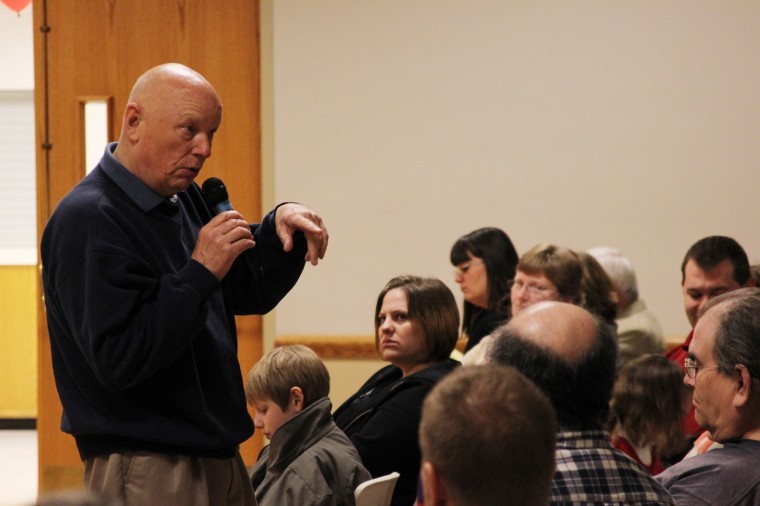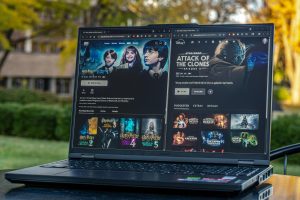‘The Beauty and Glory of Spaceflight’: Astronaut speaks about experiences, reinventing self
Astronaut Story Musgrave shares his life experience with those who came to see him speak at the Capitol Room in the Holmes Student Center Saturday evening. The former astronaut served in the Korean War as a mechanic and has flown on six space shuttle missions. One of the most important missions was STS-61, in which he repaired the Hubble Space Telescope.
April 1, 2012
Story Musgrave was a NASA astronaut for more than 30 years.
Musgrave started his career as an aircraft electrician and engine mechanic in the U.S. Marines before being employed as a scientist-astronaut by NASA in 1967.
During his career as a NASA astronaut, Musgrave performed the first shuttle spacewalk on Challenger’s first flight, flew on six shuttle missions and earned the title of lead spacewalker on the Hubble Telescope repair mission, among other achievements.
In his free time, Musgrave likes to play chess, read, garden, go parachuting and spend time with his seven kids, three grandchildren and wife, Amanda, in their Florida home.
The Northern Star sat down to talk to Musgrave about his accomplishments as an astronaut and plans for the future.
Northern Star: For those who couldn’t attend your presentation at NIU Saturday, what was your presentation “The Beauty and Glory of Spaceflight: Personal Experiences and Reflections” about?
Story Musgrave: It’s how to acquire a portfolio of things, one step at a time. Kids are in college, so it’s where you go next. What are the possibilities and opportunities? You can look at yourself as being on a playing field. Life is a continuous playing field in which you excel at how you pull your portfolio together. However, the presentation was not just for kids, because professors have to reinvent themselves, too. You’re never done reinventing yourself. It’s in the realm of personal development. My story comes from aerospace and stories that I have lived and how I have experienced them.
NS: Why did you want to be an astronaut?
SM: Exploration. It was a new playing field; it was a great playing field. It was one that provided a lot of opportunities and a lot of challenges to live up to. I joined about 45 years ago and it was a little bit newer then. It’s a mature state of the art now. It was an intellectual frontier, a new geographical frontier. I did it for the exploration, the adventure.
NS: You flew on six shuttle missions. Is there one that really sticks out in your mind?
SM: No, but there’s something that sticks out in other people’s minds: the Hubble repair mission. I spent 18 years designing it to be serviceable. I designed the telescope and serviced and maintained it until 1975.
NS: You were the first to perform a shuttle spacewalk on Challenger’s first flight. What did that feel like?
SM: I helped design the suits and life support systems. I worked on that for 13 years. It hadn’t been done before so it was a test. So it’s basically the thing you’re working on for 13 years, putting that to work.
NS: The Challenger exploded on its 10th mission in space. Do you have any thoughts on this?
SM: You grieve for your lost friends.
NS: What are your plans for the future?
SM: My plan is to keep doing what I do. Keep pushing; keep doing better and better. The work I do is very challenging and very different.
I also help companies invent their future. I have a sustained relationship with LEGO [shuttle]; I have a sustained relationship with Dell computer. I’m different than a legal consultant. It’s different than consulting; I end up being more like family.
I do aviation safety programs for the Marines. It’s a different challenge every time; it’s a different company with different needs. I have to adapt to their particular needs. That’s what life is. I reinvent myself almost every day.
I have my little granddaughter here; she’s five. So she’s a whole lot of fun. I have seven kids and I keep up with them and do stuff with them.
NS: Do you have any advice for those who want to become an astronaut?
SM: Get some education; get some technical education. Get some education in the area that relates to space life. Make sure you continue to develop your skills in teamwork and social networking. There’s nothing you can do in space life that’s not with a team. You have to demonstrate you’re comfortable in other environments. You might do some flying, some climbing, some scuba diving. It’s any kind of environment. It means you can handle yourself and do things right.
For more information on Story Musgrave and his experiences in flight, visit http://www.storymusgrave.com/index.html







